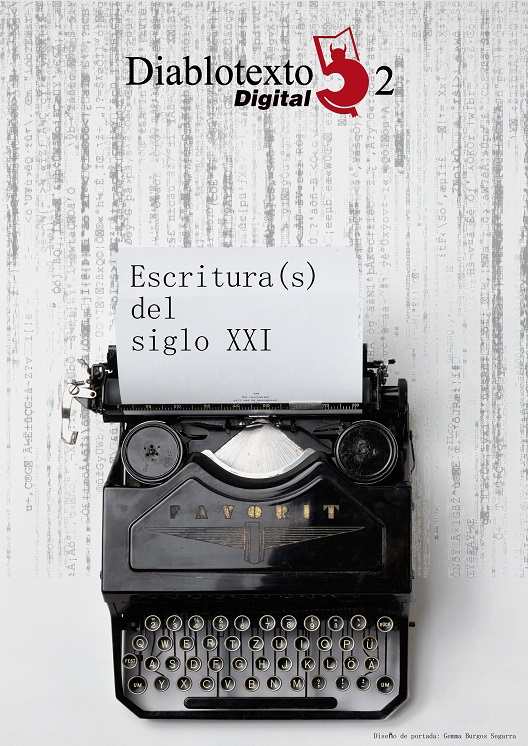Fear and memory in «El ruido de las cosas al caer» by Juan Gabriel Vásque
DOI:
https://doi.org/10.7203/diablotexto.2.10132Keywords:
Colombia, violencia, narcotráfico, memoria, miedo Abstract
Abstract
In this essay I will analyze two central topics on the novel by Juan Gabriel Vásquez: El ruido de las cosas al caer, fear and memory. Vasquez’s novel offers the readers a glimpse of the violence that hit Colombia during the last years of the 1980’s and the beginnings of the 1990’s. We don’t see these years through it’s historical figures, but through the eyes of anonymous characters which represent a whole generation that was affected for this violence. I will show how fear (it’s presence, it’s absence) is one of the most important links between the characters of the novel, and how the reflection on memory go beyond the individual and is an attempt to answer some open questions about Colombia as a society and as a country.
 Downloads
Downloads
 References
References
ADRIAENSEN, Brigitte; KUNZ, Marco (2016). Narcoficciones en México y Colombia. Madrid: Iberoamericana Vervuert.
BOLÍVAR, Gustavo (2006). Sin Tetas no hay paraíso. Barcelona: RBA.
CARUTH, Cathy (1996). Unclaimed Experience: Trauma, Narrative, and History. Baltimore: The Johns Hopkins University Press.
DE MAESENEER, Rita (2013). “Un fósforo en la oscuridad. Conversación con Juan Gabriel Vásquez”, Confluencia, vol. 28, n.º 2, pp. 209-216
ESCOBAR, Juan Pablo (2014). Pablo Escobar, mi padre. Radiografía íntima del narco más famoso de todos los tiempos. Bogotá: Planeta.
FERNÁNDEZ LUNA, Paola (2013). “El ruido de las cosas al caer: la conciencia histórica como respuesta a la estética de la narco novela en Colombia”, La palabra, n.º 22, pp. 29-39. https://doi.org/10.19053/01218530.2015
FRANCO, Jorge (1999). Rosario Tijeras. Bogotá: Plaza & Janés.
GAC-ARTIGAS, Priscilla (2015). “El ruido de las cosas al caer o la reconstrucción de una era”, Revista de la Academia Norteamericana de la Lengua Española (2015), IV, 7, pp. 165-180.
GONZÁLEZ, Aníbal (2016). “Entrando en materia: novela, poesía y cultura material en El ruido de las cosas al caer”, Cuadernos de literatura, vol. 20, n.º 40, pp. 465-477. http://dx.doi.org/10.11144/Javeriana.cl20-40.emnp
HERMAN, Judith (1997). Trauma and Recovery: The Aftermath of Violence - From Domestic Abuse to Political Terror. New York, Basic Books.
MENDOZA, Plinio Apuleyo (1990). En qué momento se jodió Colombia. Bogotá: Oveja Negra.
MONTT, Nahum (2004). El Eskimal y la mariposa. Bogotá: Alcaldía Mayor de Bogotá.
PÉREZ SEPÚLVEDA, Andrés (2013). “La caída del semblante: violencia política y social en Abril rojo de Santiago Rocangliolo y El ruido de las cosas al caer de Juan Gabriel Vásquez”, Mundo nuevo, n.º 12, pp. 49-67.
PORRAS, José Libardo (2008). Happy birthday, Capo. Bogotá: Planeta.
RESTREPO, Laura (2004). Delirio. Bogotá: Alfaguara.
RESTREPO, Laura [1993] (2001). Leopardo al sol. Barcelona: Anagrama.
(s.a.) (2015). “Sequía ‘enloquece’ a animales de Pablo Escobar”, en http://www.latribuna.hn/2015/11/30/sequia-enloquece-a-los-animales-de-pablo-escobar/ [Fecha de consulta: 28 de abril de 2017].
(s.a.) (2015). “Vuelo 965, memorias de un vuelo que nunca llegó a su destino”, en http://www.elpais.com.co/especiales/accidente-vuelo-965/ [Fecha de consulta: 28 de abril de 2017].
VALLEJO, Fernando (1994). La virgen de los sicarios. Bogotá: Alfaguara.
VÁSQUEZ, Juan Gabriel (2015). La forma de las ruinas. Bogotá: Alfaguara.
VÁSQUEZ, Juan Gabriel (2013). Las reputaciones. Bogotá: Alfaguara.
VÁSQUEZ, Juan Gabriel (2011). El ruido de las cosas al caer. Madrid: Alfaguara.
VÁSQUEZ, Juan Gabriel (2004). Los informantes. Madrid: Alfaguara.
VÁSQUEZ, Juan Gabriel (2001). Los amantes de todos los santos. Bogotá: Alfaguara.
Downloads
Published
How to Cite
-
Abstract3024
-
PDF (Español)1333
Issue
Section
License
Licencia de reconocimiento de Creative Commons “Reconocimiento - No Comercia l- Sin Obra Derivada
Authors who publish with this journal agree to the following items:
The authors will keep their copyright and guarantee the journal the right of first publication of their work, which will be simultaneously subject to the Creative Commons license that allows third parties to share the work indicating its author and its first publication in the journal. The authors may adopt other non-exclusive license agreements to distribute the version of the published work (e.g., depositing it in an institutional telematic file or publishing it in a monographic volume), with an acknowledgment of its initial publication in this journal. The authors are allowed and encouraged to disseminate their work through the Internet (e.g., in institutional telematic archives or on their website) before and during the submission process, which can produce interesting exchanges and increase citations of the published work. (See Effect of Open Access)




